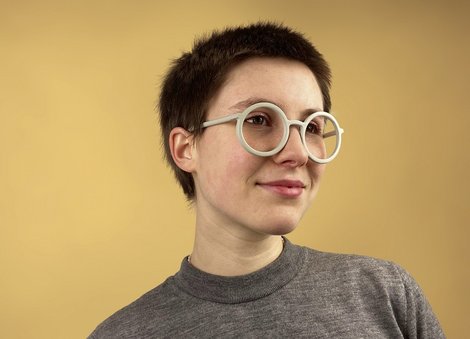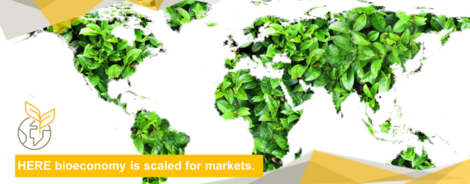A Green Future is Within Reach
Circularity, education and initiatives: creative ideas for developing the bioeconomy

The future has a long history in Saxony-Anhalt. New, industrial areas of growth are currently being developed here as part of the fundamental structural transformation as Germany looks ahead to its target of phasing out coal by 2038. In central Germany, the biobased economy is playing a leading role in this transition. The region is well on the way to becoming a full-fledged model for the bioeconomy thanks to its growing infrastructure, scientific expertise and creative potential – even in places where you might least expect it.
Max Greiner sits on the edge of his seat in eager anticipation whenever he thinks about bioplastics. His ingenious madeLocal bioplastics project is, quite literally, teeming with activity and potential. The 22-year-old industrial design student at the Burg Giebichenstein University of Art and Design in Halle recently won the BESTFORM state competition for creative design. It didn’t take the jury long to decide that his madeLocal project was worthy of the “Vision of the Year” award in recognition of “a fascinating cycle that uses a highly sustainable material and focuses on local production and scalability across many different areas.” This young pioneer from Halle (Saale) has now joined the ranks of all those in Saxony-Anhalt who are blazing the trail for the structural transformation by supporting the growth of innovative sectors – in this case the biobased economy.
Creative thinking driving development of the bioeconomy region
The bioeconomy in Saxony-Anhalt has really taken off in recent years. Large companies such as the Finnish firm UPM are investing hundreds of millions in projects like the biorefinery at the Leuna Chemical Park. Experts have identified Saxony-Anhalt as a location with “optimum conditions thanks to its growing infrastructure, scientific expertise and the strong presence of important sectors.” When Minister for the Economy and competition patron Prof. Armin Willingmann presented Greiner with his award, he highlighted another important factor: “The thriving development of the bioeconomy in Saxony-Anhalt is in part down to the creative thinking of pioneers such as the BESTFORM award winner Max Greiner. This creative mix will carry us forward over the coming years to become a leading bioeconomy region.”
Products made from chitosan: a constant cycle
The BioLab research laboratory at Burg Giebichenstein University describes itself as a “design space for vibrant futures,” and brought Greiner’s idea of a colored glasses frame prototype made of chitosan to fruition. Chitosan is a hugely versatile, but virtually unheard of, bioplastic. Greiner chose this material over a variety of bioplastics to use in his Full Circle semester project. The project task was to develop circular applications and real cycles for and with the material. The potential uses of chitosan really captured Greiner’s imagination, and, with the support of his supervisor Mareike Gast, a professor of industrial design who specializes in material and technology-based product development, he designed a cycle for the material. His project was supported by the firm madebymade in Leipzig, which could provide large quantities of chitin left over from breeding larvae for animal feed.
Greiner’s cycle revolves around the imagined company madeLocal, a cross between an insect farm and makerspace. He explained the process behind his idea: A farm produces enough waste to use as food for larvae. The insects reared on the farm are primarily used as sources of protein for animal feed. Anything left over is sold to nearby companies and industries. Yet another value chain starts when the chitin from insect exoskeletons and the outer larvae body is converted into chitosan and cast in the desired shape as a bioplastic. Greiner made a glasses frame using this method. “Children tend to break their glasses sooner or later, or they grow bigger, or their diopter number soon changes – so they get through their glasses quite quickly,” he explains. His design would allow customers to try out different frames at their opticians and to take out a glasses subscription. If the frame is too small, or gets broken, it is returned to the opticians and replaced with a new one. The old material is sent back to production. “The chitosan frames can be quickly recycled and reshaped. Recycled chitosan is added to the newly produced chitosan and then ends up in a new frame or in another chitosan-based application. This keeps it in the bioplastic cycle,” Greiner explains. This glasses leasing model is just one of many potential cycles. Greiner is convinced that “chitosan’s innumerable properties mean that many other collaborative projects are possible,” citing water purification firms, textile companies, chemists and pharmacies as potential partners. For him, raising chitosan’s profile is key. “Chitosan also has potential for use in medicine or as a wound treatment cream, is biodegradable and decomposes in soil,” he goes on to say. The aim of his experiments in the BioLab was to prove that this type of project really is feasible. “The research lab is the ideal place for this kind of work. We are working on lots of pioneering projects,” says Prof. Gast.
Awesome algae: experiment kits for sustainable education
Another creative project is also harnessing the power of experiments to pave the way for the future of the bioeconomy by teaching the younger generation all about the uses of algae. Industrial designer Lara Rockenstein, who has a master’s degree from the University of Magdeburg, has developed an algae experiment kit together with Roquette algae farm in Klötze and the educationalist Christian Bass. The kit comes in twelve versions and encourages children to learn about topics such as photosynthesis through stirring, mixing and exploring. Roquette Managing Director Jörg Ullmann is now hoping to find a potential partner to take over the production of the glass kits, which include instructions, samples and a pump designed in-house. “It would be fantastic if children could soon be learning about algae and understand how it grows, what impact it has, how it affects water, and how it can be used in the food industry,” says Ullmann.
Author: Manuela Bock/IMG Sachsen-Anhalt

As a long standing location for the nutrition, chemicals, wood/cellulose and agricultural economy,
we have excellent knowledge of renewable resources and biotechnology processes as the basis for industry, energy and nutrition.
